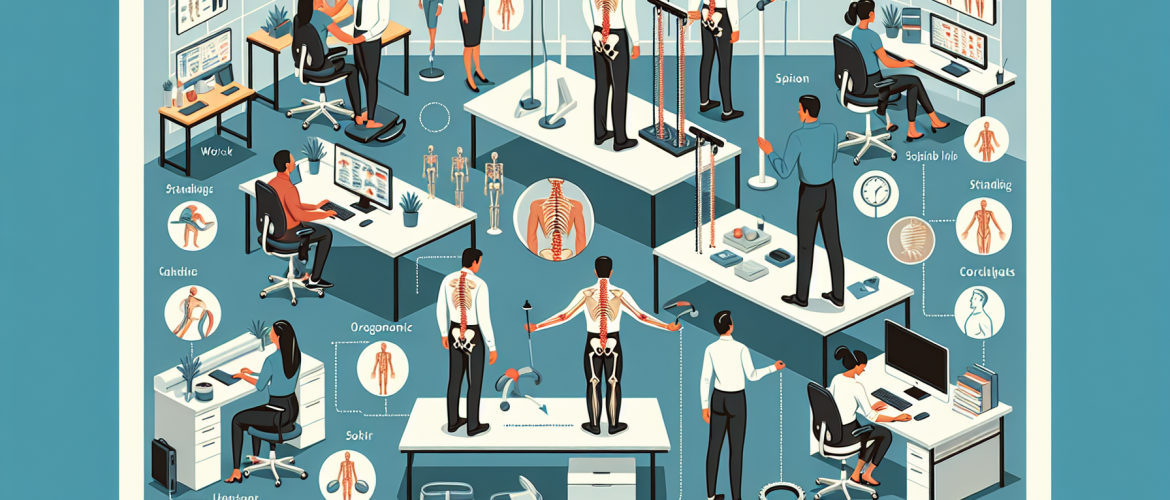Are you tired of dealing with chronic back or neck pain that affects your productivity at work? Look no further than Henry Chiropractic, a trusted chiropractic clinic in Pensacola, Florida. Owned and operated by Dr. Craig Henry, a licensed chiropractor, Henry Chiropractic is dedicated to improving the health and wellness of its patients using chiropractic care. Alongside Dr. Henry, Dr. Aaron Hixon, a board-certified chiropractor, is passionate about helping others and is trained in a range of chiropractic techniques. With their expertise, you can prevent workplace injuries and start feeling better in all areas of your life.

Table of Contents
The Importance of Workplace Injury Prevention
Workplace injuries can have a significant impact on both employees and employers. They can result in physical pain, reduced productivity, increased healthcare costs, and potential legal issues. Therefore, it is crucial to prioritize workplace injury prevention to ensure the well-being and safety of everyone in the workplace.
Understanding the impact of workplace injuries
Workplace injuries can range from minor accidents to severe, life-altering incidents. These injuries can occur across different industries and job roles. Some common types of workplace injuries include slips and falls, musculoskeletal disorders, repetitive strain injuries, and accidents involving machinery or vehicles.
When employees suffer from workplace injuries, they may experience physical pain, emotional distress, and financial burdens. These injuries can lead to medical expenses, lost wages, and a decreased quality of life. On the other hand, employers bear the responsibility of providing compensation and care for injured employees, which can lead to higher insurance premiums and a decrease in overall productivity.
Benefits of injury prevention programs
Implementing injury prevention programs in the workplace can yield numerous benefits. By taking proactive measures to identify and address potential hazards, companies can minimize the occurrence of workplace injuries and create a safe and healthy work environment. Some key benefits of injury prevention programs include:
-
Reduced healthcare costs: By preventing workplace injuries, companies can significantly reduce healthcare expenses related to employee injuries and illnesses.
-
Increased productivity: When employees are healthy and free from injury, they are more likely to perform at their best, resulting in increased productivity levels.
-
Improved employee morale and satisfaction: A workplace that prioritizes the well-being of its employees fosters a positive and supportive environment. This, in turn, leads to higher employee morale and job satisfaction.
-
Lower workers’ compensation costs: By preventing workplace injuries, companies can avoid the costs associated with workers’ compensation claims, insurance premiums, and legal fees.
-
Enhanced reputation: Companies that prioritize workplace safety and injury prevention build a positive reputation among employees, customers, and the general public.
Role of chiropractic principles in preventing workplace injuries
Chiropractic care offers a holistic and proactive approach to preventing and addressing workplace injuries. With a focus on spinal health and overall wellness, chiropractic principles can play a significant role in ensuring the well-being of employees. By incorporating chiropractic care into workplace injury prevention programs, companies can benefit from the expertise of chiropractors in the following ways:
Understanding Chiropractic Principles
Chiropractic care is a healthcare discipline that emphasizes the importance of maintaining proper spinal health and alignment to promote overall wellness. Chiropractors believe that the spine plays a crucial role in the body’s ability to function optimally. By ensuring a well-aligned spine, chiropractors aim to enhance the body’s natural healing abilities and prevent health issues from arising.
The concept of chiropractic care revolves around the idea that misalignments in the spine, known as subluxations, can disrupt the nervous system’s functioning, leading to various health problems. By applying manual adjustments and other specialized techniques, chiropractors seek to correct these subluxations and restore proper alignment.
Focus on spinal health and alignment
Chiropractors prioritize spinal health and alignment as the foundation for overall well-being. Through gentle adjustments and spinal manipulations, chiropractors aim to improve nerve function, reduce pain, and enhance the body’s natural healing abilities. By addressing spinal imbalances, chiropractors can help prevent workplace injuries and promote long-term health.
Holistic approach to wellness
Unlike traditional medical approaches that often focus solely on symptom management, chiropractic care takes a holistic approach to wellness. Chiropractors consider the interconnectedness of the body’s systems and how each component contributes to overall health. This comprehensive perspective allows chiropractors to identify underlying issues that may contribute to workplace injuries and provide targeted preventive care.
Common Workplace Injuries
Understanding the types and causes of workplace injuries is crucial for effective injury prevention. By identifying the specific risks and hazards associated with different job roles, companies can implement targeted preventive measures to mitigate the occurrence of injuries. Some common workplace injuries include:
Types of workplace injuries
-
Falls: Slips, trips, and falls are among the most common workplace injuries. They can occur due to wet or slippery surfaces, uneven flooring, poor lighting, or inadequate safety measures.
-
Musculoskeletal disorders: These injuries affect the muscles, bones, tendons, ligaments, and other components of the musculoskeletal system. They often result from repetitive motions, improper lifting techniques, or maintaining awkward postures for extended periods.
-
Strains and sprains: These injuries typically occur when muscles or ligaments are stretched or torn due to sudden or excessive force. They can result from lifting heavy objects, overexertion, or sudden movements.
-
Cuts and lacerations: Workplaces that involve the use of sharp tools or machinery can pose a risk of cuts and lacerations. This includes industries such as construction, manufacturing, and food service.
Causes and risk factors
Workplace injuries can stem from various causes and risk factors. Some common causes include:
-
Lack of appropriate safety protocols: Companies that do not prioritize safety measures, such as providing protective equipment or proper training, increase the risk of workplace injuries.
-
Poor ergonomics: Workstations that do not support proper posture or require repetitive or strenuous movements can lead to musculoskeletal disorders and other injuries.
-
Fatigue and stress: Employees who are fatigued or stressed are more susceptible to accidents and injuries due to decreased focus and coordination.
-
Inadequate maintenance and equipment: Poorly maintained machinery, faulty equipment, or outdated safety measures can increase the risk of workplace injuries.
Impact on employees and employers
Workplace injuries can have significant consequences for both employees and employers. For employees, injuries can result in physical pain, emotional distress, and financial burdens. They may require time off work for recovery, leading to lost wages and potential long-term disability. Additionally, workplace injuries can negatively impact an employee’s overall quality of life and well-being.
Employers bear the responsibility of providing compensation, medical care, and rehabilitation services for injured employees. This can result in increased insurance premiums, legal fees, and potential reputational damage. Workplace injuries also disrupt productivity and may require hiring temporary or replacement workers.
The Role of Chiropractic Care in Workplace Injury Prevention
Chiropractic care offers valuable insights and interventions for preventing workplace injuries and promoting overall employee well-being. By incorporating chiropractic principles into workplace injury prevention programs, companies can take proactive measures to minimize the occurrence of injuries. Some key roles of chiropractic care in workplace injury prevention include:
Evaluating workplace ergonomics
Chiropractors are trained to evaluate workplace environments and identify ergonomic factors that contribute to injuries. They assess factors such as workstation setup, seating arrangements, and repetitive motion tasks to determine potential risks. By identifying ergonomic issues, chiropractors can recommend adjustments or modifications to prevent injuries and promote optimal workplace health.
Identifying and addressing musculoskeletal imbalances
Chiropractors are experts in identifying musculoskeletal imbalances that can increase the risk of workplace injuries. Through comprehensive evaluations, including posture analysis and movement assessments, chiropractors can pinpoint areas of weakness or misalignment. By addressing these imbalances through manual adjustments, exercises, and therapeutic techniques, chiropractors can reduce the risk of future injuries.
Providing preventive maintenance care
Regular chiropractic visits can be a proactive approach to preventing workplace injuries. Chiropractors can provide preventive maintenance care aimed at ensuring optimal spinal health and alignment. Through routine adjustments, posture correction, and personalized wellness plans, chiropractors can promote overall well-being and reduce the likelihood of workplace injuries.
Ergonomics: Creating a Safe and Healthy Work Environment
Ergonomics plays a critical role in preventing workplace injuries and creating a safe and healthy work environment. By considering the interaction between employees and their workstations, companies can optimize ergonomics and minimize the risks of musculoskeletal disorders and other injuries. Understanding ergonomics and its importance is key to implementing effective preventive measures.
Understanding ergonomics and its importance
Ergonomics is the science of designing and arranging the physical environment to fit the needs of the individual. In the workplace, ergonomics focuses on creating workstations and tasks that maximize efficiency and minimize the risk of injury. By considering factors such as posture, repetitive motions, and workspaces, companies can optimize ergonomics and reduce the risk of workplace injuries.
Assessing workplace ergonomics
Evaluating workplace ergonomics involves analyzing various components, including workstation design, seating arrangements, and the physical demands of tasks. Companies can conduct ergonomic assessments or enlist the expertise of chiropractors and other professionals to identify potential ergonomic issues. Through these assessments, companies can gain insights into areas that require improvement and implement appropriate solutions.
Implementing ergonomic solutions
Once ergonomic issues are identified, companies can take steps to implement solutions that improve workplace ergonomics. This may include providing adjustable chairs and desks, ensuring proper lighting and ventilation, and encouraging frequent breaks and stretching. By incorporating ergonomic solutions, companies can create a work environment that supports employee well-being, reduces injury risks, and promotes productivity.
Musculoskeletal Imbalances: Addressing Underlying Issues
Musculoskeletal imbalances can contribute to workplace injuries and should be addressed to prevent further harm. Chiropractors specialize in identifying and treating these imbalances, providing targeted interventions to support employee health and safety.
Effects of musculoskeletal imbalances on workplace injuries
Musculoskeletal imbalances, such as misalignments or weaknesses in the musculoskeletal system, can increase the risk of workplace injuries. These imbalances can affect posture, coordination, and range of motion, making employees more susceptible to accidents and strains. By addressing these underlying issues, companies can significantly reduce the occurrence of workplace injuries.
Identifying imbalances through chiropractic evaluation
Chiropractors are trained to assess and identify musculoskeletal imbalances through comprehensive evaluations. They analyze posture, movement patterns, and specific muscle imbalances to pinpoint areas of concern. This evaluation process allows chiropractors to develop personalized treatment plans that address the underlying issues contributing to workplace injuries.
Treating imbalances through chiropractic adjustments and therapies
Chiropractic adjustments and therapies play a crucial role in correcting musculoskeletal imbalances and preventing workplace injuries. Through manual adjustments, chiropractors can realign the spine and other joints, improving balance, mobility, and overall function. Additionally, chiropractors may utilize therapies such as soft tissue mobilization, myofascial release, and corrective exercises to address imbalances and promote optimal musculoskeletal health.
Preventive Maintenance Care: Keeping Employees Healthy
Regular chiropractic visits for preventive care can play a significant role in keeping employees healthy and reducing the risk of workplace injuries. By prioritizing preventive maintenance care, companies can invest in their employees’ wellness and well-being.
Regular chiropractic visits for preventive care
Encouraging employees to schedule regular chiropractic visits for preventive care can have a positive impact on their overall health. These visits allow chiropractors to monitor spinal health, identify potential issues, and provide appropriate interventions before they develop into more significant problems. By addressing minor imbalances or discomfort early on, employees can maintain optimal musculoskeletal health and reduce the risk of workplace injuries.
Benefits of routine chiropractic adjustments
Routine chiropractic adjustments offer numerous benefits for employees. These adjustments help maintain proper spinal alignment, which promotes nerve function, reduces pain, and enhances overall well-being. By addressing musculoskeletal imbalances and spinal misalignments, routine chiropractic care can improve balance, coordination, and prevent injuries related to posture and movement. Employees who prioritize routine chiropractic care are more likely to experience improved energy levels, reduced pain, and overall enhanced quality of life.
Education and training for employees
In addition to providing chiropractic care, chiropractors can also educate and train employees on injury prevention strategies. Education initiatives can include seminars, workshops, or one-on-one consultations where chiropractors share insights on proper lifting techniques, ergonomics, and exercises to improve core strength and flexibility. By empowering employees with knowledge and self-care techniques, companies can foster a culture of wellness and reduce the risk of workplace injuries.
Chiropractic Techniques for Workplace Injury Prevention
Chiropractic techniques play a vital role in preventing workplace injuries by addressing musculoskeletal imbalances and promoting optimal spinal health. Chiropractors utilize various techniques tailored to the specific needs of each individual to ensure effective preventive care.
Diversified technique for spinal adjustments
The diversified technique is one of the most commonly used chiropractic techniques for spinal adjustments. It involves manual adjustments targeting misalignments in the spine and other joints. By applying precise and controlled force, chiropractors can correct subluxations, enhance nerve function, and restore proper alignment. The diversified technique is versatile and can be adapted to address various musculoskeletal issues, making it effective for preventing workplace injuries.
Gonstead Spinal Manipulation for precise alignment
The Gonstead technique is another chiropractic method aimed at achieving precise spinal alignment. Chiropractors using this technique perform thorough assessments to identify spinal misalignments and then apply specific adjustments to correct those issues. By addressing these misalignments, chiropractors can enhance nerve function, promote optimal musculoskeletal health, and reduce the risk of workplace injuries.
Instrument Assisted Soft Tissue Mobilization (IASTM) for muscle therapy
Chiropractors may also utilize Instrument Assisted Soft Tissue Mobilization (IASTM) as part of injury prevention strategies. IASTM involves the use of specialized instruments to apply controlled pressure and tension to soft tissues, such as muscles and fascia. This technique helps break up adhesions, scar tissue, and trigger points, improving blood circulation, reducing pain, and enhancing flexibility. By incorporating IASTM, chiropractors can optimize muscle function and decrease the likelihood of workplace-related muscle strains and injuries.
Other Preventive Measures for Workplace Injury Prevention
In addition to chiropractic care, implementing other preventive measures can further enhance workplace injury prevention efforts. By promoting exercise, educating employees on proper lifting techniques, and addressing stress management and mental health support, companies can create a comprehensive approach to employee well-being and safety.
Exercise and stretching routines for employees
Encouraging employees to engage in regular exercise and stretching routines can strengthen muscles, improve flexibility, and reduce the risk of workplace injuries. Providing access to on-site fitness facilities, organizing group exercise classes, or implementing structured break times for physical activity are effective ways to promote employee fitness. By incorporating exercise into the daily routine, companies can support musculoskeletal health and overall well-being.
Proper lifting techniques and body mechanics
Teaching employees proper lifting techniques and emphasizing correct body mechanics is essential for preventing workplace injuries. Companies can provide training sessions or workshops focused on safe lifting practices, including techniques such as squatting, using the legs for power, and keeping the back straight. By educating employees on proper lifting techniques, companies can minimize the risk of strains, sprains, and other injuries associated with lifting heavy objects.
Stress management and mental health support
Workplace stress can have a significant impact on employee well-being and increase the risk of injuries. Employers should promote stress management strategies and provide mental health support to create a healthy work environment. This can include implementing stress reduction programs, offering counseling services, and encouraging healthy work-life balance. By addressing stress and mental health concerns, companies can help prevent workplace injuries related to reduced focus, fatigue, and reduced coordination.
Collaboration and Education for Effective Workplace Injury Prevention
Collaboration between employers, chiropractors, and healthcare professionals is vital for effective workplace injury prevention. By engaging in open communication and education initiatives, companies can create a culture of wellness and prioritize the well-being of their employees.
Collaboration between employers, chiropractors, and healthcare professionals
Creating effective workplace injury prevention programs requires collaboration and cooperation between employers, chiropractors, and other healthcare professionals. Employers can work closely with chiropractors to develop customized injury prevention strategies that address specific workplace needs. By fostering open communication and sharing information on job requirements and potential hazards, employers can support chiropractors in providing targeted preventive care.
Educating employees on injury prevention strategies
An informed and educated workforce is better equipped to prevent workplace injuries. Employers should prioritize employee education on injury prevention strategies, such as proper lifting techniques, ergonomics, and self-care practices. Chiropractors can play a crucial role in providing workshops, seminars, or one-on-one consultations to educate employees on the importance of musculoskeletal health and injury prevention. By empowering employees with knowledge and resources, companies can foster a sense of ownership and responsibility for their well-being.
Creating a culture of wellness in the workplace
To effectively prevent workplace injuries, companies must create a culture of wellness and prioritize employee well-being. This involves promoting a supportive work environment that values health, safety, and work-life balance. By implementing wellness initiatives, offering resources for stress management, and encouraging open communication, companies can create a workplace culture that prioritizes the physical and mental well-being of their employees. A culture of wellness promotes employee engagement, reduces injury risks, and enhances overall productivity and satisfaction.
In conclusion, workplace injury prevention is of utmost importance for both employees and employers. By understanding the impact of workplace injuries, recognizing the benefits of injury prevention programs, and incorporating chiropractic principles, companies can take proactive steps to create a safe and healthy work environment. Through ergonomic assessments, addressing musculoskeletal imbalances, providing preventive maintenance care, and implementing other preventive measures, companies can significantly reduce the risk of workplace injuries. Collaboration between employers, chiropractors, and healthcare professionals, along with employee education and a culture of wellness, are key to effective workplace injury prevention. With a commitment to prioritizing employee well-being and safety, companies can create a workplace that promotes optimal health, productivity, and overall success.





